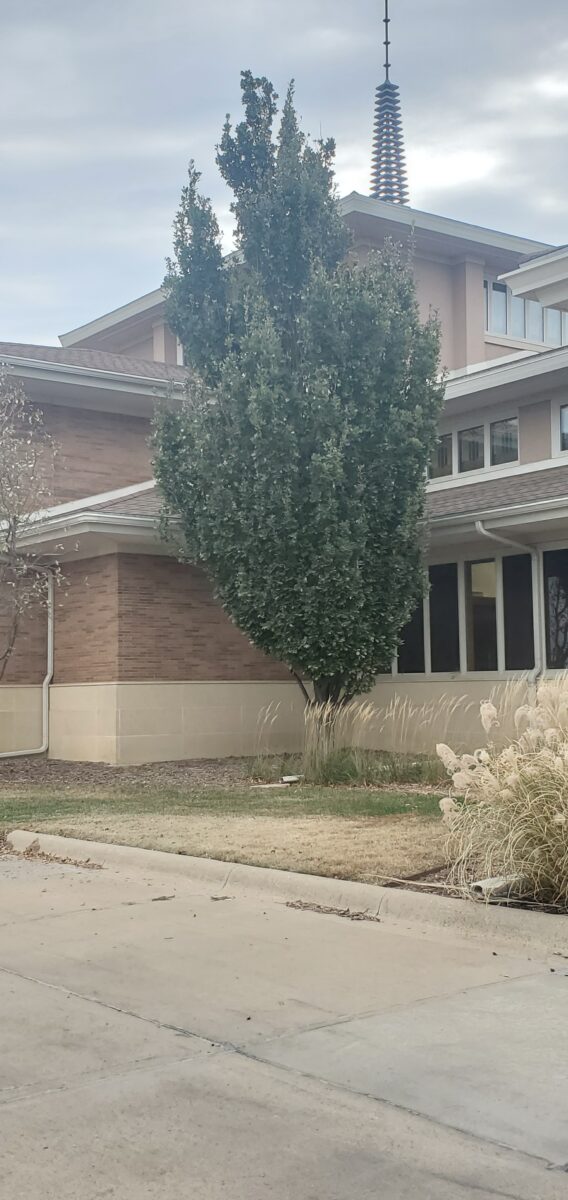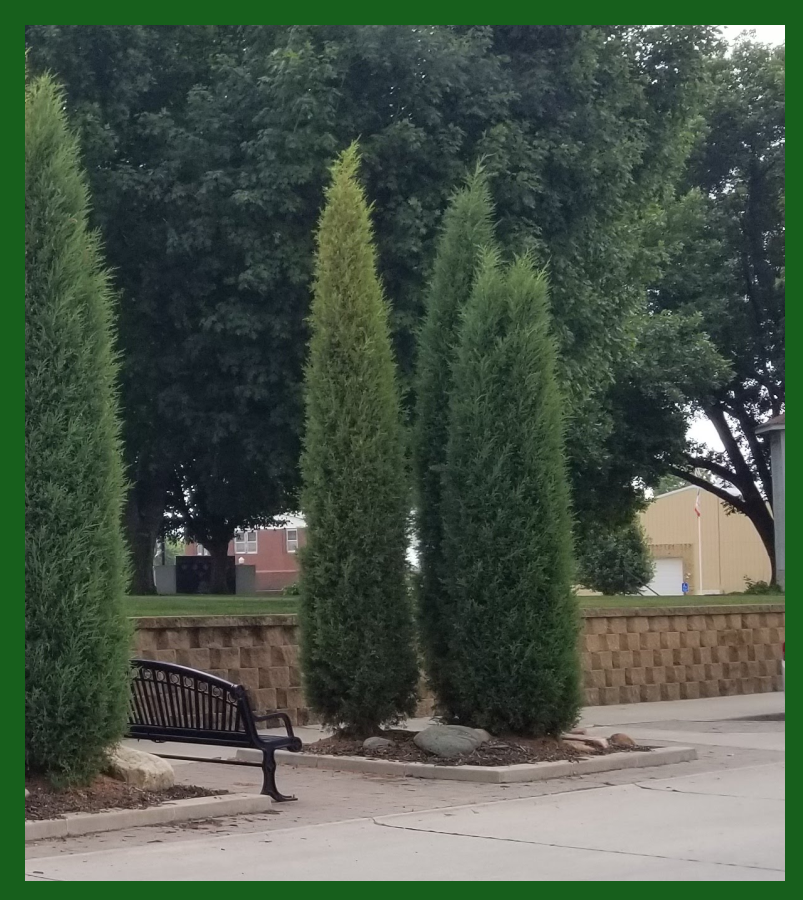What are columnar trees? In short, these are trees that have narrow, upright canopies. They are usually dense in foliage too. Columnar trees have many purposes, even though the average homeowner cannot see it when they visit the nursery. I do not get a lot of requests for these trees, but we always keep some on hand. And let me tell you why.
There are a lot of reasons to plant columnar trees in the landscape. They work great up against a building or house, where space is limited, but you need something to soften the edge. Or they can be planted in groupings as a screen to block a view or lessen the wind. I have seen several times where a client planted columnar trees along the edge of their pool to screen it from the neighbors. Or you can use a grouping of them along with shrubs and perennials to break the monotony of a large lawn.
There are two types of columnar trees; evergreen or deciduous. They both have pros and cons. But ultimately, it is how you want to use them in your landscape which will make the decision on which to use.
Evergreen Columnar Trees
Even among evergreens, there are different sizes of columnar trees. You can have skinny and short, or skinny and tall. There is quite a bit of variation among the different species of trees, and their cultivars. Evergreen columnar trees are the best ones for screening views and windbreaks. But they have some issues too. I would not recommend planting them along the side of a pool or anywhere you might wish to go barefoot. The needles, especially those from spruce and juniper are painful to walk on.
But if you use them as a cluster to break up an open space, or soften the edges of a stone or brick house, then you have placed them well. Adding evergreen columnar trees to the landscape, if done correctly, can create an Italian or Mediterranean feel. But they need to match your architecture too. If you have a log cabin or country ranch, adding evergreens may actually produce a negative feel to the landscape. So choose wisely.
Cultivars of Evergreens
- Green Arrow Alaska Cedar looks like a weeping pine crossed with an arborvitae. But its an incredibly tough tree and narrow to boot. It grows 30 feet tall and just 5 feet wide.
- Weeping Alaskan Cedar is very comparable to the above cultivar, growing only 30 feet tall and 10 feet wide. It has a great look for an ornamental spot in the garden.
- The Columnar Norway Spruce grows 30 feet tall and 10 feet wide. The dark green, slightly weeping foliage gives it a unique look, similar to the Italian Cypress, which will not grow in the Central Great Plains.
- Taylor Juniper is a popular evergreen which is very hardy in our area. It grows 20 feet tall by 4 feet wide and is very drought and heat tolerant.
- Skyrocket junipers have blue-green foliage on plants that grow 15 feet tall by 3 feet wide. I recommend clustering these in the landscape.
- Spartan juniper grows 20 feet tall by 5 feet wide and is an excellent choice along wing walls at 2 story brick homes or banks.
- Private Jet arborvitae grows 20 feet tall by 5 feet wide and has a softer look than many of the other evergreens.

Deciduous Columnar Trees
There is a lot more variety when it comes to deciduous trees, than there is with evergreens. It is typically that way in nature too. Many of these columnar trees are best suited for wither home landscape, or mixed in around churches, wedding venues, or in parks. And it is because of their potential fruiting possibilities. (They can be messy). But others fit better along city streets, driveways, pools, or parking areas where space is limited for trees. City managers prefer seedless columnar trees for downtown greenspaces because they do not grow too much over the street or into adjoining buildings.

Trees Greater Than 15 Feet Wide
I am separating the deciduous trees into width groupings.
- Fran Fontaine hornbeam is a great tree for alongside pools and patios. it does grow 35 feet tall by 15 feet wide, but it has no major seed production to float in the pool or lay on the patio. Expect leaves to fall after pool time is over.
- Rising Fire American hornbeam is similar to the above tree is size, growing 30 feet tall by 15 feet wide. The fall color is amazing on this tree. I recommend using it alongside pools, decks, and patios as a screening tree.
- Heartland Catalpa was chosen by Doug Grimm from a variety of trialed catalpas. It grows 50 feet tall by 25 feet wide, and is a great winter interest tree with the hanging pods. It has fragrant flowers and tropical looking leaves.
- The Princeton Sentry ginkgo is a nice, slow-growing addition to the garden. It is seedless and has some of the best yellow fall color of any tree. It grows 40 feet tall by 15 feet wide.
- Streetkeeper honeylocust was developed for downtown city streets because of its upright habit. It grows 45 feet tall and 20 feet wide and is seedless.
- Skinny Latte coffeetree is a new addition to the group, growing 50 feet tall by 18 feet wide. It is seedless and a great, tough tree for almost any situation.
- Crimson Spire oak has beautiful red fall color. It grows 45 feet tall by 15 feet wide. And it looks great next to a limestone courthouse!
- Prairie Gold aspen is another great tree with good yellow fall color. It grows 40 feet tall by 15 feet wide and looks great in clusters of three.
Trees Between 10 and 15 feet Wide
- Copper Rocket paperbark maple is a great new tree that grows 25 feet tall by 12 feet wide. You can put it in sun or part shade and the fall color with amaze you.
- Prairie Sentinel hackberry grows 45 feet tall by 12 feet wide and is a great street tree. Butterflies will love this tree!
- Saffron Sentinel Cornelian cherry dogwood not only is columnar, but has edible fruit in late summer too! It grows 22 feet tall by 12 feet wide.
- Skinny Genes oak grows 45 feet tall by 10 feet wide. It is a great addition as a screen or along a fence.
- Streetspire Oak was developed to grow along city streets. It grows 45 feet tall by 14 feet wide.
Columnar Trees Less Than 10 Feet Wide
- Standing Ovation serviceberry is not very tall, but it is not very wide either. And it has edible fruit. It grows 15 feet tall by 7 feet wide.
- Parkland Pillar birch is another great tree for downtown or for putting along the landscape of a house. It grows 30 feet tall by 8 feet wide.
- The only problem with Slender Silhouette sweetgum is that it has messy fruit. This tree grows 60 feet tall by 8 feet wide and has excellent fall foliage.
- Ivory Spear crabapple grows 18 feet tall by 7 feet wide with white spring flowers. The fruit is eaten by birds.
- Raspberry Spear crabapple is similar to the above, by slightly taller. It grows 20 feet tall by 8 feet wide with purple foliage and pink flowers.
- Mountain Sentinel aspen grows 40 feet tall by 8 feet wide and has bright yellow fall foliage.
- Kindred Spirit oak is the skinniest oak I know of, growing 30 feet tall by just 6 feet wide. This is an oak for downtown!
Companion Plants for Columnar Trees
Even when putting these vertical trees into the landscape, you cannot use them by themselves. It is best to pair them with other trees, shrubs, grasses, and perennials which will help them stand out among the landscapes around them. Tall things, such as houses and other structures, as well as trees, need to have companions that lessen their perceived height, and make them easier on the eye. I dislike it when a tall building put in with short foundation plantings around it. Plant something tall, medium and short!

The good news is that many things go well with evergreens, especially other evergreens and grasses. If you are using deciduous columnar trees, then pair them with flowering shrubs and grasses. For a taller tree, try to pair it with something that is around 1/2 to 2/3 of its expected height. Then the next plant should be 1/2 to 2/3 of that plant. And so on and so forth.

One way to achieve this effect is to start with other columnar plants, then downsize to grasses and other shrubs. The above quick sketch is a sampling of what you could do, but you are only limited by your plant palette and imagination. Also, trees used in cityscapes like downtown rarely need a companion because they are companions to the tall buildings around them. But it may be wise to consider the height of the building or tallest structure in the landscape, and do not use plants that are too tall in comparison.
Conclusion
Columnar trees are needed especially when trying to reduce the height or soften the hard lines of a taller structure within the landscape. They can also be used to break up an open stretch of landscape, such as a meadow, large turfgrass lawn, or prairie.
Happy planting!




